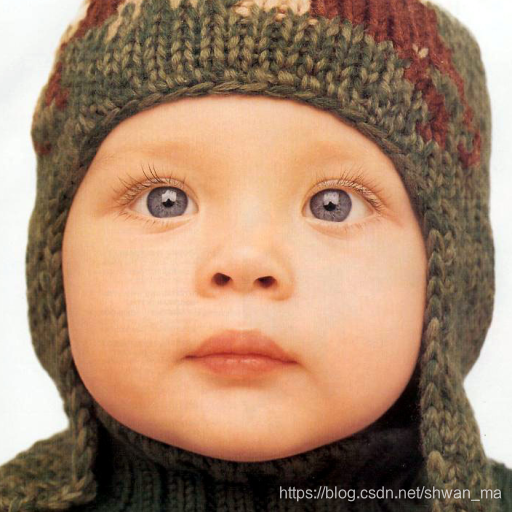【超解析度】python中的影象空間的轉換 RGB--YCBCR
阿新 • • 發佈:2018-12-06
由於人眼對顏色不敏感,而對光亮通道更加敏感。因此在超解析度任務中,我們通常需要將RGB通道轉換為Ycbcr通道。在Python的程式碼實現中,我發現opencv的RGB轉Ycbcr的計算方式和Matlab的實現方式有些不同,而NTIRE的評估往往是在matlab平臺的。因此,這裡需要注意。
Python RGB轉Ycbcr通道
對於Set5中的baby影象

Code:
img = cv2.imread(imgpath) img = cv2.cvtColor(img, cv2.COLOR_BGR2YCR_CB) img_y = img[:,:,0]
Result:
array([[253, 253, 253, ..., 254, 254, 254], [253, 253, 253, ..., 254, 254, 254], [253, 253, 253, ..., 254, 254, 254], ..., [ 62, 70, 72, ..., 67, 67, 67], [ 54, 58, 59, ..., 69, 68, 68], [ 49, 52, 53, ..., 70, 70, 69]], dtype=uint8)
實驗原理:

參考連結:https://docs.opencv.org/3.0.0/de/d25/imgproc_color_conversions.html
Matlab RGB轉Ycbcr通道
Code:
im = imread(imgpath);
im = rgb2ycbcr(im);
im = im(:, :, 1);
Result:

Matlab實現方式:
function ycbcr = rgb2ycbcr(varargin)
%RGB2YCBCR Convert RGB color values to YCbCr color space.
% YCBCRMAP = 實驗可發現兩種實現方式的結果存在著不同, 這是因為兩者的內部實現原理不同。這裡提供一個與Matlab的Ycbcr空間轉換類似的函式:
def rgb2ycbcr(img, only_y=True):
'''same as matlab rgb2ycbcr
only_y: only return Y channel
Input:
uint8, [0, 255]
float, [0, 1]
'''
in_img_type = img.dtype
img.astype(np.float32)
if in_img_type != np.uint8:
img *= 255.
# convert
if only_y:
rlt = np.dot(img, [65.481, 128.553, 24.966]) / 255.0 + 16.0
else:
rlt = np.matmul(img, [[65.481, -37.797, 112.0], [128.553, -74.203, -93.786],
[24.966, 112.0, -18.214]]) / 255.0 + [16, 128, 128]
if in_img_type == np.uint8:
rlt = rlt.round()
else:
rlt /= 255.
return rlt.astype(in_img_type)
